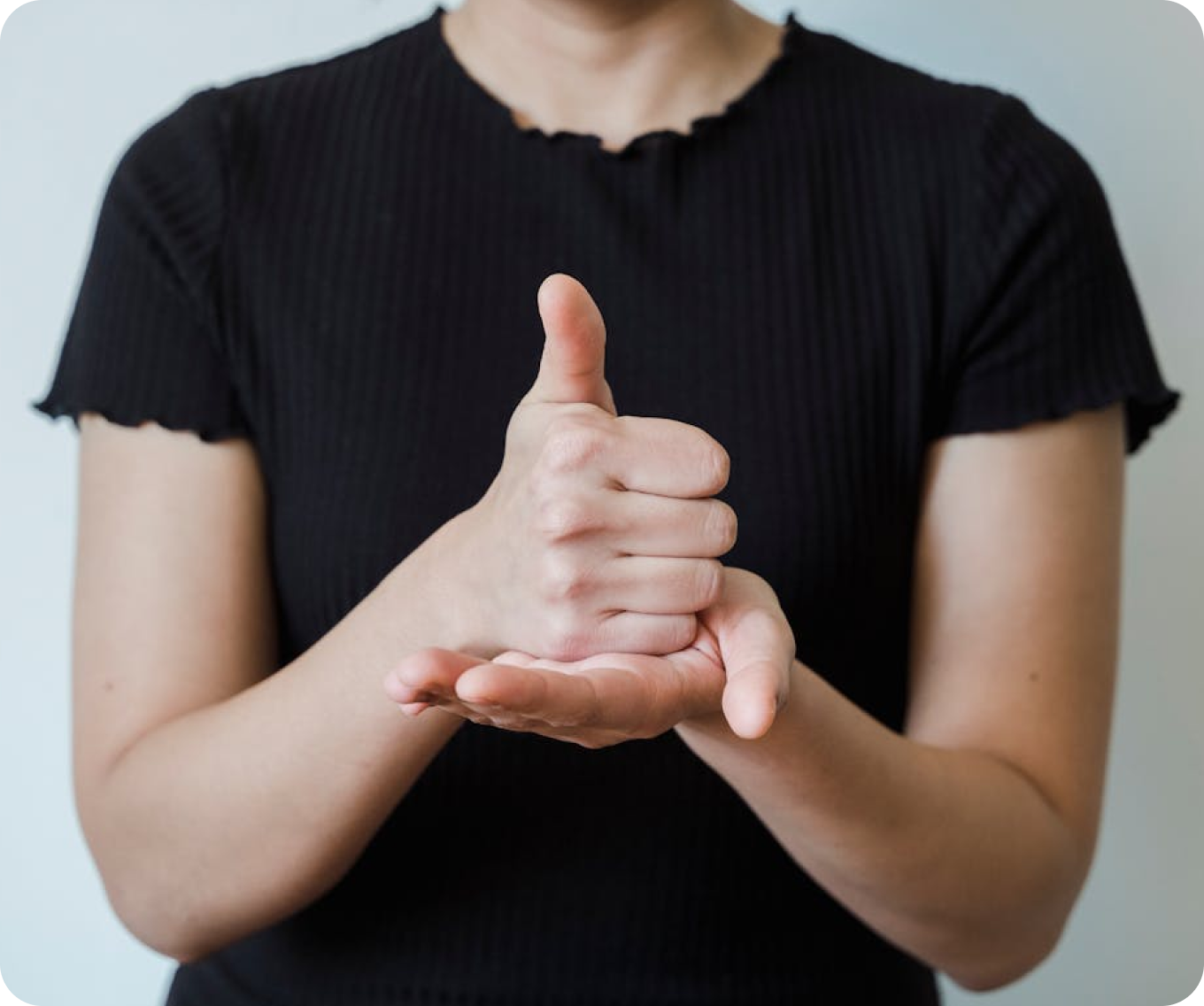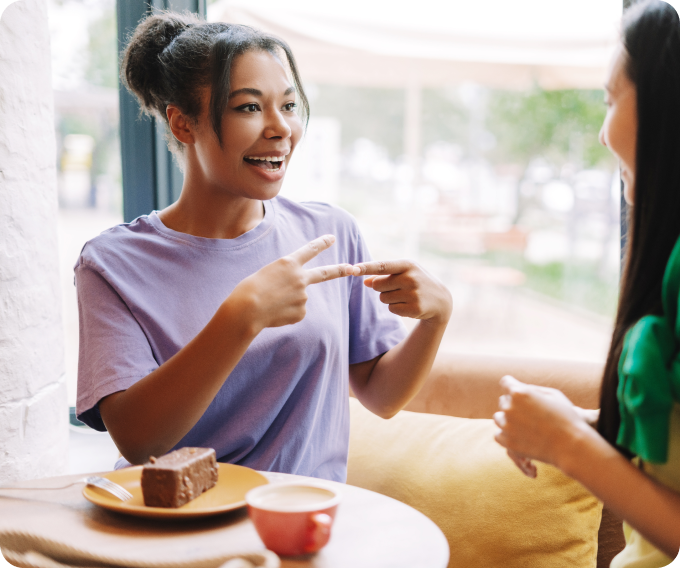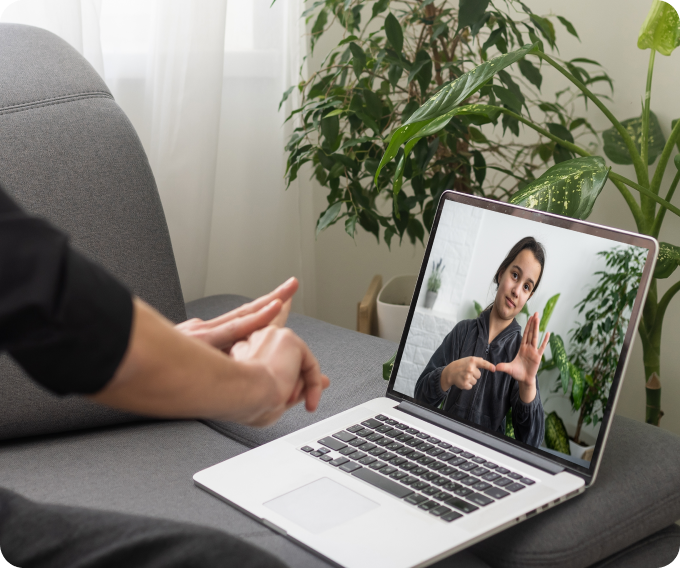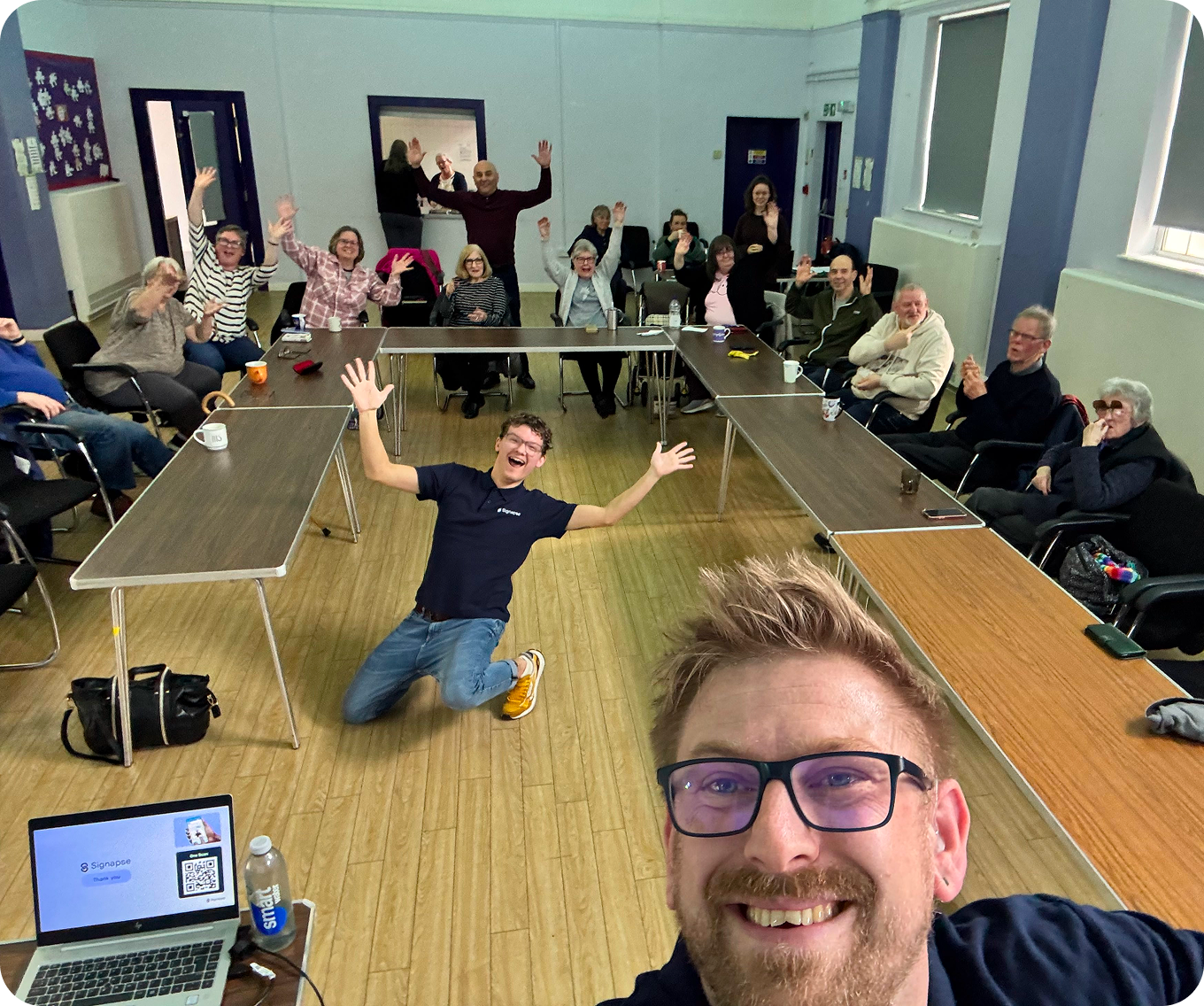What is BSL?: A Complete Guide to British Sign Language

Language is at the heart of how we connect with one another. It’s the way we share stories, exchange ideas and build communities. But for many Deaf people in the UK, spoken English isn’t their native language. Instead, they use British Sign Language (BSL). In fact, data shows at least 22,000 people use BSL as their main language in England and Wales with an estimated 150,000 people using BSL as a language overall.
BSL is more than a tool for communication. It’s part of a vibrant culture, a source of identity and a symbol of resilience and activism. This guide serves as your introduction to BSL, covering its history, how it functions as a language, where it is used and its role in the Deaf community. Join us as we delve into the question “What is BSL?”.
- What is BSL? A Complete Guide to British Sign Language
- What is BSL?
- A Brief History of BSL
- BSL as a Language
- Where is BSL Used?
- BSL in the Deaf Community
- Common Misconceptions About BSL
- How to Learn BSL
- The Future of BSL
- Understanding the Nuances of BSL
What is BSL?
British Sign Language (BSL) is the language used by many Deaf people across the UK. Unlike spoken or written English, it is a visual-spatial language, expressed through hand shapes, movements, facial expressions and body language.
Most importantly, BSL has its own grammar and syntax, which are entirely different from English. For example, while English follows a Subject-Verb-Object order (”I am going to the shop”), BSL may structure the same idea differently, using space and emphasis in ways that don’t exist in spoken language. More often than not, BSL follows a Topic-Comment grammatical structure or sometimes an Object-Subject-Verb (OSV) structure.
BSL is also not a universal language. Each country (and sometimes even regions within a country) has its own signed languages. For instance, American Sign Language (ASL) is completely different from BSL, despite both being used in English speaking countries. Similarly, Irish Sign Language (ISL), Australian Sign Language (Auslan) and New Zealand Sign Language (NZSL) are all distinct languages.
A Brief History of BSL
Signed communication in Britain can be traced back centuries. Historical records suggest signs were used among Deaf people as early as the 16th century. One famous example is when Thomas Tilsye used sign language in his wedding vows in 1576.
The development of BSL as we know it today was strongly influenced by Deaf education in the 18th and 19th centuries. A key figure was Thomas Braidwood, who opened Britain’s first school for the Deaf in Edinburgh in 1760. While his teaching methods were often oralist (focusing on speech), his work brought together a community of Deaf children who shared and expanded their signing systems.
Over time, BSL evolved into a recognised community language. However, the 19th and 20th centuries saw setbacks. Following the famous Milan Conference of 1880, which favoured oralism, sign languages were banned from many schools worldwide. Deaf children in Britain were forced to lip-read and speak rather than sign, leading to a suspension of BSL in education. Despite this, the language survived and flourished within Deaf communities.
The late 20th century is where things really started to change. After decades of campaigning, BSL was officially recognised as a minority language in 2003. More recently, the BSL Act 2022 requires UK government departments to promote and facilitate BSL use. These milestones reflect both the resilience of the Deaf community and growing recognition of linguistic diversity.
BSL as a Language
Like any language, BSL has its own alphabet, rules, grammar and expressive power. From grammar to region variations, here’s a breakdown of what sets BSL apart from spoken language and other sign languages.
- Grammar and Syntax: BSL relies on word order, spatial placement and non-manual features (like eyebrow raises or head tilts) to convey meaning. For example, a simple question may be indicated not just by hand signs but by facial expression too.
- Use of Space: People who use sign language often use the space around them to represent people, places or ideas. Once something is “placed” in signing space, it can be referred back to throughout the conversation.
- Facial Expressions: Expression are not just emotional cues but grammatical markers. They can indicate questions, emphasis or tone.
- Regional Variations: Just like spoken dialects, BSL has regional differences. A sign used in London might different from one in Manchester or Glasgow.
It’s also important to distinguish BSL from related sign systems:
- Sign Supported English (SSE): A way of representing spoken English word-for-word, using signs but following English grammar.
- Makaton: A simplified system using signs and symbols, often used alongside speech to support people with learning or communication difficulties.
Where is BSL Used?
BSL is used throughout the UK by thousands of people, not only Deaf individuals but also their families, friends**,** interpreters and teachers.
You can find BSL being used in a wide range of settings:
- Education: Some schools for the Deaf use BSL as the primary language of instruction.
- Workplaces: Employers increasingly provide interpreters to make workplaces accessible.
- Healthcare: BSL interpreters are vital for ensuring access to medical appointments.
- Media and Politics: From TV programmes with in-vision interpreters to political speeches being signed live, BSL has an expanding presence in public life.
- Community and Culture: Social gathering, theatre performances and festivals often use BSL as the medium of communication.
It’s important to remember that BSL isn’t limited to Deaf users. Many hearing children of Deaf adults (known as CODAs) grow up bilingual in BSL and English.
BSL in the Deaf Community
For many Deaf people, BSL is more than a language. It’s the heart of their cultural identity. Language creates community, and for the Deaf community, BSL offers belonging, shared experiences and intergenerational connection.
Deaf culture celebrates BSL through storytelling, theatre, poetry and humour. These artistic forms of expression demonstrate the creativity and richness of visual language. Community events such as Deaf clubs and festivals also strengthen social bonds.
At the same time, BSL plays a role in advocacy and rights movements. Campaigns for access to interpreters, education and media representation have been central to the push for equality. Many Deaf people see the recognition and promotion of BSL as a fundamental aspect of respect and inclusion.
Common Misconceptions About BSL
Despite growing awareness, myths about BSL are still common. Here are some of the biggest myths debunked:
1. “BSL is universal”
False. Every country has its own sign language and they are as different as spoken languages.
2. “BSL is just English signed”
Incorrect. BSL has its own grammar and syntax. Sign Supported English is different from BSL.
3. “Deaf people can just lip-read or use subtitles”
Lip-reading is extremely difficult and unreliable. Even the best lip-readers may only catch a fraction of what is said. Subtitles are also inaccessible for people whose first language isn’t English or another form of spoken language.
4. “Only Deaf people use BSL”
Many hearing people use BSL! Family members, interpreters, teachers and friends are only a few examples.
5. “BSL is outdated now that we have technology”
Technology like captions, video relay services or sign language translators help, but they don’t replace a natural, visual language.
How to Learn BSL
Anyone can learn BSL! Whether you want to support a Deaf friend, expand your skills or pursue a career as an interpreter, there are accessible pathways available.
- Courses: Many colleges, universities and community organisations offer classes. Online courses and apps are also growing in popularity. Find a BSL course near you from courses that lead you to qualifications and certifications.
- Qualifications: BSL courses are typically structured in levels:
- Level 1: Basic conversational signs
- Level 2: More complex communication and grammar.
- Level 3 and Beyond: Advanced proficiency and preparation for interpreting.
- Practice: The best way to improve is to interact with native signers. Attending Deaf community events or joining online practice groups can be a great way to start conversations!
- Career Opportunities: BSL skills are in demand in education, healthcare, social care, interpreting and media.
Learning BSL isn’t just about language; it’s about connecting with a community and embracing a different way of seeing the world.
Becoming a Sign Language Interpreter
If you want to take your BSL to the next level, you could become a sign language interpreter. To do this, you must fulfill the following steps:
- Achieve Level 6 in BSL: You need to complete a Level 6 Certificate in British Sign Language before you can begin an interpreter course. This can be a Level 6 Diploma in Sign Language Interpreting or a MA in Interpreting (BSL/English).
- Register as a Trainee Sign Language Interpreter (TSLI): After achieving your Level 6 BSL qualification, you can then enroll onto an interpreting training course. There is a limit to the amount of interpreting work you can do, but this is one step towards becoming a fully qualified BSL interpreter.
- Qualify and Register as a Registered Sign Language Interpreter (RSLI): Once you have completed your interpreting qualification and passed all assessments, you can register as an RSLI with the National Registers of Communication Professionals working with Deaf and Deafblind People (NRCPD). This qualification allows you to work in all settings including courts, NHS and government.
The Future of BSL
BSL has come an long way and continues to gain visibility and recognition. But, there is still a long way to go! The BSL Act 2022 is a major step forward, requiring government departments to promote BSL. This means future policies may further improve accessibility and set an example for organisations in the future.
There is growing pressure for more schools to offer BSL classes and for Deaf children to have the right to learn in their first language. But, with the demand for qualified BSL interpreters outpacing supply, this has become a challenge in recent years.
The solution? We believe technology is the answer to bridging these gaps. Tools such as video relay interpreting, AI translation and other accessibility devices can be used to expand access in public spaces. However, these tools should be used to complement rather than replace human interaction.
How Signapse are Contributing to This Future
At Signapse, our AI sign language translators are here to aid where appropriate. From translating important travel information in airports and train stations to ensuring digital accessibility on websites and promoting inclusion in marketing materials, our technology can be used in a multitude of ways to prioritise accessibility where it is needed most.
Understanding the Nuances of BSL
BSL is a vibrant, unique language with a history of resilience, a thriving culture and a growing role in modern society. Far from being “just another tool for communication”, BSL is a natural language that deserves the same respect as spoken languages.
Understanding BSL helps us challenge misconceptions, support inclusion and appreciate the richness of Deaf culture. Whether you’re thinking about learning BSL yourself, supporting a Deaf friend or family member, or simply broadening your awareness, taking the time to learn more about the Deaf community is helping us all work towards a more accessible and connected world.
FAQs
How many people are Deaf in the UK?
There are around 87,000 Deaf people in the UK who use British Sign Language (BSL) as their first or preferred language. In total, about 12 million people in the UK have some degree of hearing loss.
What is the difference between BSL, Makaton and SSE?
BSL is a full, natural language with its own grammar and syntax, used primarily by the Deaf community. Makaton is a simplified system of signs and symbols designed to support people with learning disabilities, while SSE (Sign Supported English) uses BSL signs but follows spoken English word order rather than BSL grammar.
When was BSL invented?
BSL was not “invented” at a single moment but developed naturally over centuries within Deaf communities in Britain. Its roots can be traced back at least to the 16th century, with significant growth in the 18th century through Deaf schools.
Related Articles
How CVG Airport used AI to provide live updates in American Sign Language
The Importance of Cultural and Linguistic Awareness in Sign Language Technology



